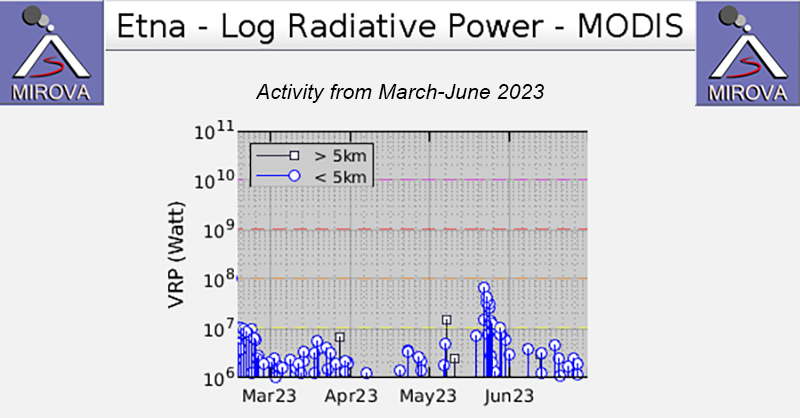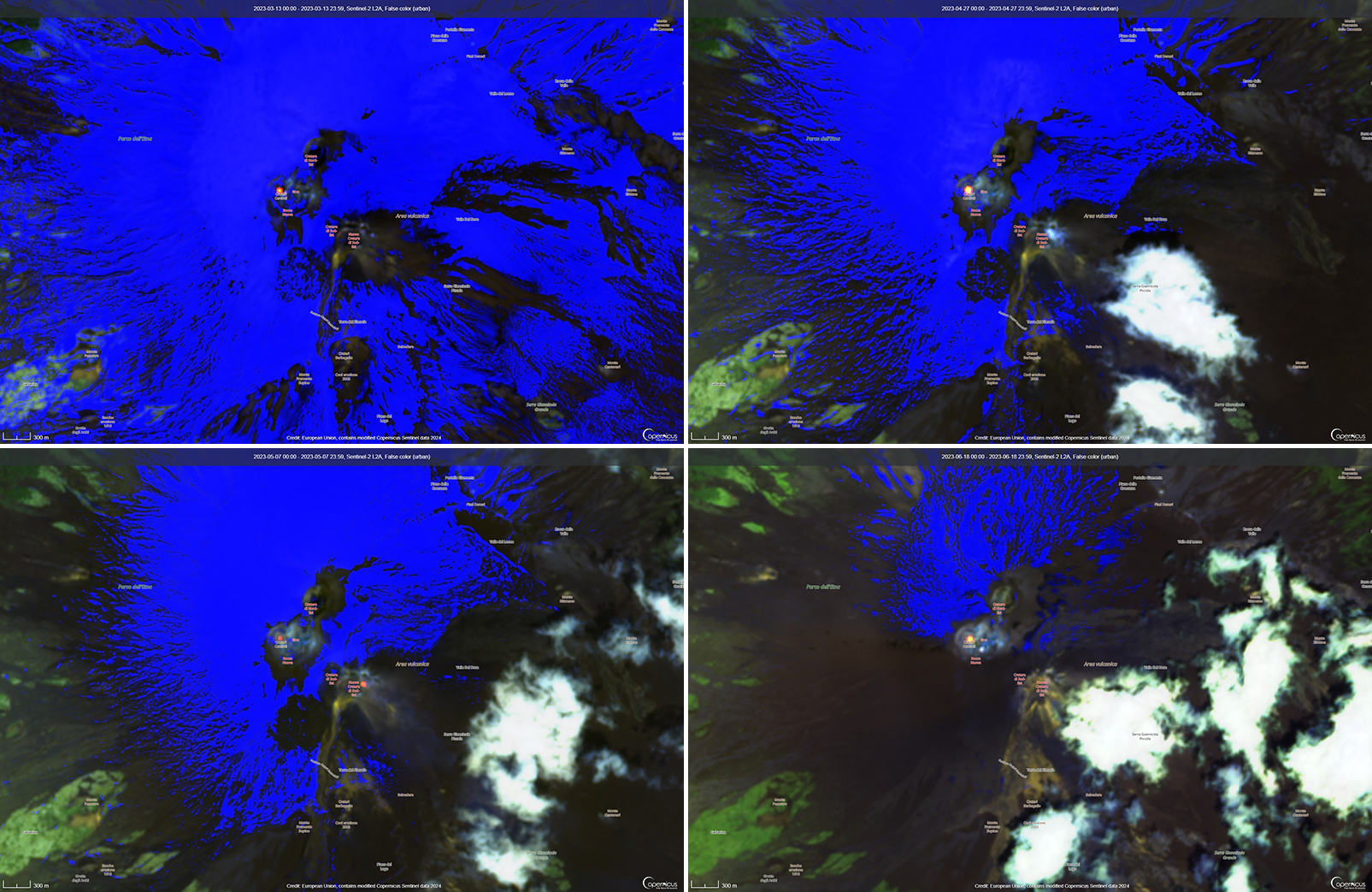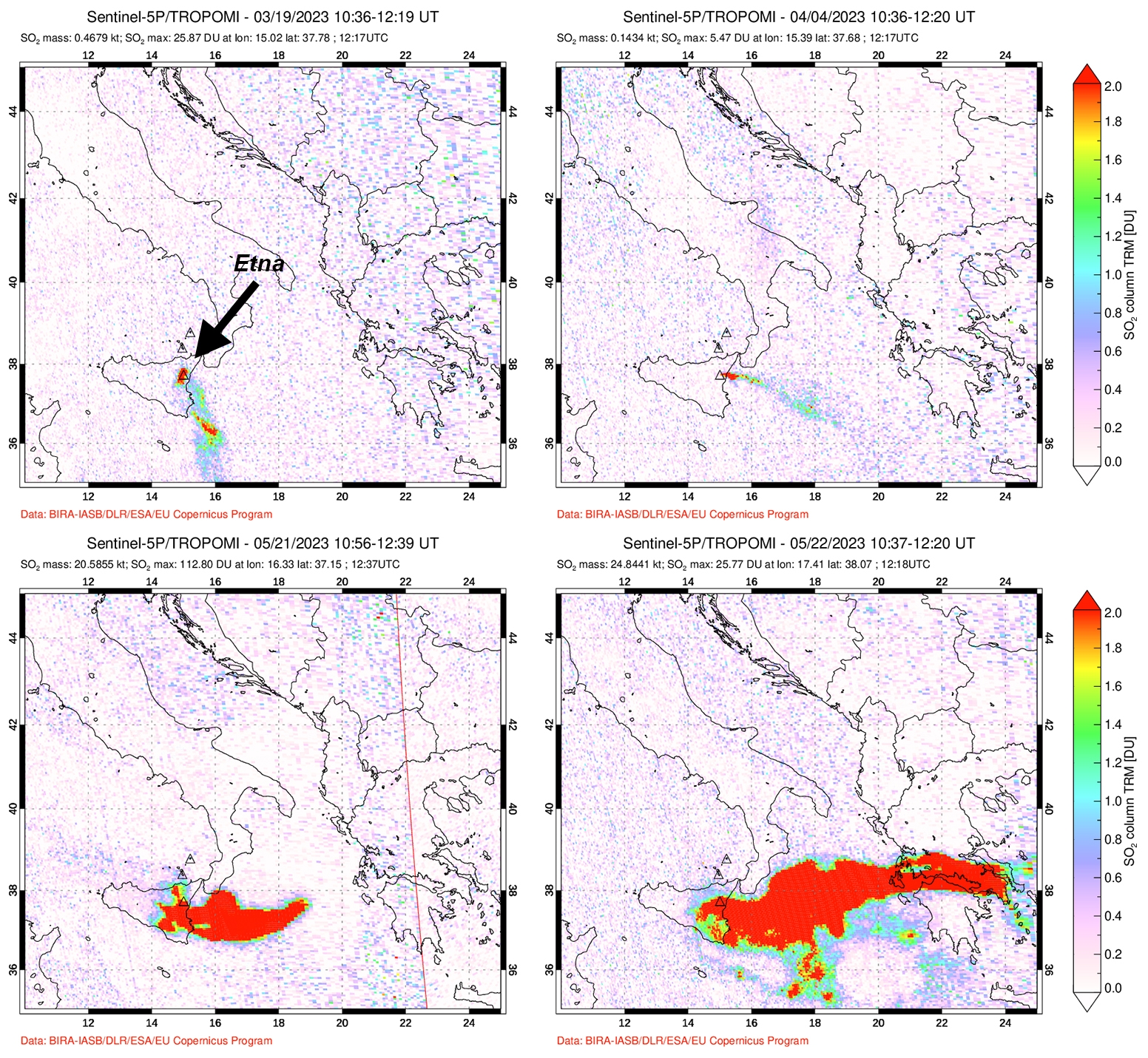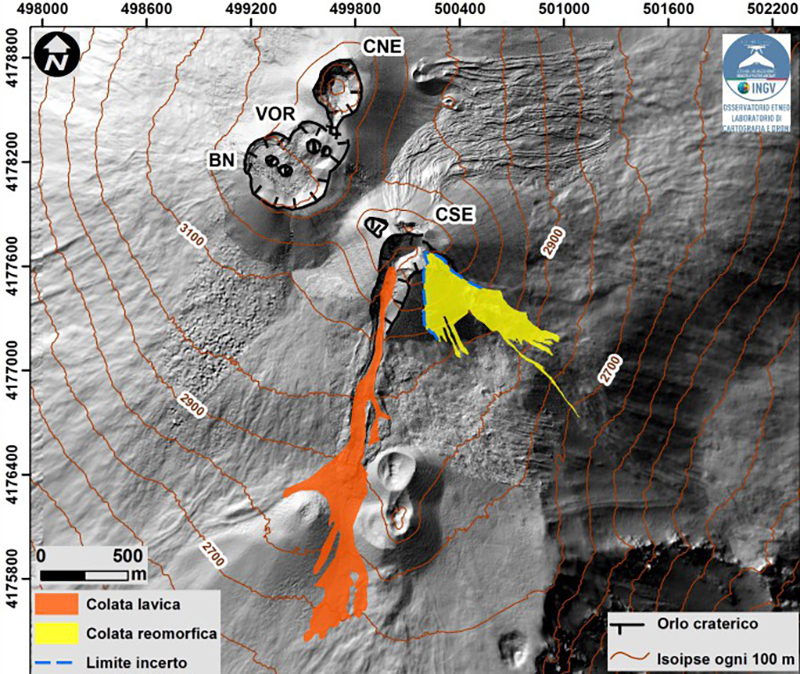Report on Etna (Italy) — August 2023
Bulletin of the Global Volcanism Network, vol. 48, no. 8 (August 2023)
Managing Editor: Benjamin Andrews.
Edited by Kadie L. Bennis.
Etna (Italy) Intermittent Strombolian activity, lava flows, and ash plumes during March-June 2023
Please cite this report as:
Global Volcanism Program, 2023. Report on Etna (Italy) (Bennis, K.L., and Andrews, B., eds.). Bulletin of the Global Volcanism Network, 48:8. Smithsonian Institution.
Etna
Italy
37.748°N, 14.999°E; summit elev. 3357 m
All times are local (unless otherwise noted)
Etna, on the Italian island of Sicily, has had documented eruptions dating back to 1500 BCE. Activity typically originates from multiple cones at the summit, where several craters have formed and evolved. The currently active craters are Northeast Crater (NEC), Voragine (VOR), and Bocca Nuova (BN), and the Southeast Crater (SEC); VOR and BN were previously referred to as the “Central Crater”. The original Southeast crater formed in 1978, and a second eruptive site that opened on its SE flank in 2011 was named the New Southeast Crater (NSEC). Another eruptive site between the SEC and NSEC was referred to as the "cono della sella" (saddle cone) and developed during early 2017. The current eruption period began in November 2022 and has been characterized by new, active vents, and lava flows (BGVN 48:03). This report updates activity during March through June 2023, which includes Strombolian activity, lava flows, and ash plumes, based on weekly and special reports by the Osservatorio Etneo (OE), part of the Catania Branch of Italy's Istituo Nazionale di Geofisica e Vulcanologica (INGV) and satellite data.
Variable fumarolic degassing was reported at all summit craters Bocca Nuova (BN), Voragine (VOR), Northeast Crater (NEC), and Southeast Crater (SEC) throughout the entire reporting period. The MIROVA (Middle InfraRed Observation of Volcanic Activity) volcano hotspot detection system based on the analysis of MODIS data showed frequent but low-power thermal anomalies throughout the reporting period (figure 393). There was a short break in activity during mid-April and a pulse of stronger thermal activity during late May. Infrared satellite imagery captured a persistent thermal anomaly at the central summit crater area (figure 394). On 7 May a second thermal anomaly was also visible in SEC. Accompanying thermal activity were occasional sulfur dioxide plumes that exceeded 2 Dobson Units (DUs) recorded by the TROPOMI instrument on the Sentinel-5P satellite (figure 395). During 21-22 May notably strong sulfur dioxide plumes drifted E and occurred around the same time as the strong pulse in thermal activity as shown on the MIROVA graph.
Table 14. Summary of activity at the four primary crater areas at the summit of Etna during March-June 2023. Information is from INGV weekly reports.
| Month | Bocca Nuova (BN) | Voragine (VOR) | Northeast Crater (NEC) | Southeast Crater (SEC) |
| Mar 2023 | Continuous degassing. | Weak fumarolic degassing. | Weak fumarolic degassing. | Variable fumarolic degassing at the crater rim and fractures along the cone. |
| Apr 2023 | Continuous degassing. | Weak fumarolic degassing. | Weak fumarolic degassing. | Intense fumarolic degassing at the crater rim and fractures along the cone. |
| May 2023 | Continuous degassing. Strombolian activity. | Fumarolic degassing. | Fumarolic degassing. | Continuous degassing. Strombolian activity. Lava flows. |
| Jun 2023 | Continuous degassing. | Weak degassing. | Weak degassing. | Continuous degassing. |
Activity during March and April was relatively low and mainly consisted of variable degassing at the summit craters. According to INGV weak explosions that ejected ash were detected on 8 and 14 May at SEC. During 18-19 May eruptive activity resumed, consisting of Strombolian activity at BN and SEC, though there were only short periods of visibility due to weather conditions. Strombolian activity from SEC began at 0456 on 18 May, based on webcam images taken from a camera at Montagnola. The Aviation Color Code (ACC) was raised to Yellow (the second lowest level on a four-color scale) at 1242 after a sudden increase in volcanic tremor amplitude that began at 1210. A seismic swarm in the summit area at 1644 was immediately followed by ground deformation recorded at the Punta Lucia and Pizzi Deneri summit stations. On 18 May at 1700 explosive activity was observed in BN based on infrared webcam images from Bronte (13 km WNW). The ACC was raised to Orange (the second highest level on a four-color scale) at 1751. On 19 May around 0456 weak intra-crater Strombolian activity was also recorded at SEC based on images taken by the Montagnola webcam. INGV reported that it was possible intermittent explosive activity occurred during 19-20 May.
There was a sharp increase in volcanic tremors at 0720 on 21 May. During 0730-1140 on 21 May the explosive activity at SEC evolved to lava fountaining, accompanied by an ash plume that drifted as far as 10 km and ashfall to the SW, S, and SE (figure 396). The ACC was raised to Red (the highest level on a four-color scale) at 0937 due to ash and lapilli on the SW flank, affecting the area between Adrano village at 560 m elevation and Catania as well as Aci Castello. According to news reports the ashfall caused the Catania-Fontanarossa Airport in Sicily to close until 0900 on 22 May. The runway had been covered in ash and at least 68 flights to and from the airport were cancelled. In addition, lava flows were also reported from SEC that moved S and E from the summit; the flows expanded to the W part of BN and near Monte Frumento Supino, as seen in Landsat 8 data. The S flow reached about 2 km in length, while the one in the Valle del Bove was 1.9 km long and extended E. According to quantitative estimates, the lava covered 300,000 m2 and expanded to 2.3 km in length (figure 397). A strong sulfur dioxide plume that drifted E was also captured in satellite imagery (figure 395). The ACC was lowered to Orange at 0601 on 22 May, though the lava flows remained active. During 23-24 May weak intra-crater explosive activity was observed at SEC (figure 398) and some flashes of incandescence were visible at BN. The ACC was lowered to Yellow at 0840 on 23 May and then to Green at 1051. A drone overflight was conducted on 27 May that observed the lava flows and tephra deposits emplaced during 21 May. Flows had traveled 2.3 km and descended to 2,650 m elevation. During a field inspection on 28 May volcanologists observed gas emissions rising from BN and fumarolic activity at both VOR and NEC.
 |
Figure 396. Photo of ashfall near Etna from explosive activity at the Southeast crater on 21 May 2023. Courtesy of Boris Behncke, INGV. |
 |
Figure 398. Photo of weak intra-crater explosive activity at Etna’s Southeast Crater on the evening of 23 May 2023. Photo has been color corrected. Courtesy of Boris Behncke, INGV. |
During June, activity was relatively low and mainly consisted of degassing at each of the summit craters. On 8 June during 2248-2250 a thermal anomaly was visible on the S flank of SEC in webcam images. An analysis of the image noted that this was due to a collapse in an unstable part of the cone, which exposed hot material. In addition, based on visual and thermal surveillance cameras on Montagnola, a short series of hot material moved down the slope.
Geological Summary. Mount Etna, towering above Catania on the island of Sicily, has one of the world's longest documented records of volcanism, dating back to 1500 BCE. Historical lava flows of basaltic composition cover much of the surface of this massive volcano, whose edifice is the highest and most voluminous in Italy. The Mongibello stratovolcano, truncated by several small calderas, was constructed during the late Pleistocene and Holocene over an older shield volcano. The most prominent morphological feature of Etna is the Valle del Bove, a 5 x 10 km caldera open to the east. Two styles of eruptive activity typically occur, sometimes simultaneously. Persistent explosive eruptions, sometimes with minor lava emissions, take place from one or more summit craters. Flank vents, typically with higher effusion rates, are less frequently active and originate from fissures that open progressively downward from near the summit (usually accompanied by Strombolian eruptions at the upper end). Cinder cones are commonly constructed over the vents of lower-flank lava flows. Lava flows extend to the foot of the volcano on all sides and have reached the sea over a broad area on the SE flank.
Information Contacts: Sezione di Catania - Osservatorio Etneo, Istituto Nazionale di Geofisica e Vulcanologia (INGV), Sezione di Catania, Piazza Roma 2, 95123 Catania, Italy (URL: http://www.ct.ingv.it/it/); MIROVA (Middle InfraRed Observation of Volcanic Activity), a collaborative project between the Universities of Turin and Florence (Italy) supported by the Centre for Volcanic Risk of the Italian Civil Protection Department (URL: http://www.mirovaweb.it/); NASA Global Sulfur Dioxide Monitoring Page, Atmospheric Chemistry and Dynamics Laboratory, NASA Goddard Space Flight Center (NASA/GSFC), 8800 Greenbelt Road, Goddard MD 20771, USA (URL: https://so2.gsfc.nasa.gov/); Copernicus Browser, Copernicus Data Space Ecosystem, European Space Agency (URL: https://dataspace.copernicus.eu/browser/); Boris Behncke, Istituto Nazionale di Geofisica e Vulcanologia (INGV), Sezione di Catania, Piazza Roma 2, 95123 Catania, Italy (Twitter: https://twitter.com/etnaboris); MSN, Mount Etna eruption: Flights canceled after Catania Airport runway covered in volcanic ash (URL: https://www.msn.com/en-us/travel/news/mount-etna-eruption-flights-canceled-after-catania-airport-runway-covered-in-volcanic-ash/ar-AA1bxuub).





